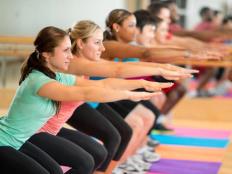
In 2017 when I realized I would have to forego my earbuds to participate in a 70.3 Ironman race, I almost rescinded my entry. I know it seems dramatic, but for me, the idea of not running to a curated playlist was torturous. Playing music while running helped distract me and kept me from getting bored. Maybe you can relate to my dilemma?
Instead of backing out of the event, however, I flipped the script. I decided to take the "no headphone" rule as a new challenge and integrated it into my training. Eventually, I found a rhythm between my body and my breath, even entering a flow state while melody free. Unbeknownst to me, I was meditating while running.
This article will take a look at what meditation means, the benefits of meditation, and how to incorporate meditation into your cardio.
Mindfulness vs. Meditation
Often mindfulness and meditation are used synonymously despite being two distinct entities. Mindfulness is a quality that describes a particular way of living that can be cultivated through practice. Meditation is a practice used to develop distinct qualities, including mindfulness. Repetitive, rhythmic cardio, like running or rowing, is a great partner for both.
Benefits of Meditating While Exercising
It's no secret that exercise can help improve one's physical and mental health. Meditation, too, has been proven effective for helping to reduce symptoms of anxiety and depression. So, what about both at the same time? Researchers have been studying the range of benefits of combining meditation with exercise for years.
The use of meditation while performing an aerobic exercise has been known to:
- Reduce symptoms of anxiety and depression
- Reduce the chance of injuries
- Improve the overall performance of endurance athletes
- Improve sleep quality
- Improve mood and overall well-being
From novice athletes to elite performers, everyone can benefit from incorporating meditation into their exercise routine.
Full-body endorphins, meditative movement. Get started on your journey to cardio Nirvana with Hydrow. Hydrow offers several full-body rowing workouts that fall into three intensity categories: Breathe, Sweat, and Drive. Tackle them individually or combine them for a dynamic rowing program.
Where to Focus
You've decided to forego your earbuds. Now what? Fortunately, you have all the tools necessary to cultivate a cardio meditation practice. Start by reviewing the possibilities below. There are also options for guided meditation via apps and other programs, but we are highlighting a technology-free cardio meditation experience.Pick one or two options and experiment to find what fits your preferences or needs.
1. Focus On Your Breath
You can start your cardio meditation practice by focusing on your breath. Nasal breathing is a common breathing technique that allows for better focus. An example would be bringing an inhale in through the nose for three counts, followed by an exhale through the nose for three counts. The even distribution of air ensures a steady breathing rate. You can increase or decrease the count as needed. Rhythmic breathing, or aligning your breath with your body's rhythm, is another method. To practice rhythmic breathing, use belly breathing and a five-count pattern. For example, while running, take three steps as you inhale and two steps as you exhale.
2. Focus On Your Tempo
Focus on how your feet are landing on the ground as you run. Are they landing too hard? Can you land lighter? Or focus on how your strokes feel as you row. Are they smooth and controlled?
3. Perform a Body Scan
Your lungs are burning, but what about the rest of your body? This is the perfect opportunity to perform a body scan. Start at your feet; how are your toes feeling? Focus on your ankles, then your knees, and up through your thighs. Now check in with your IT bands and hips. Are you swaying or running straight? Is your abdomen tight? Are you holding your breath or does it move with ease? Are you leading with your body or are your shoulders over your hips? Are your elbows staying tucked in while you row or are they splaying out? Are you wearing your shoulders like earrings? Relax your shoulders. Shake out your hands. Relax your jaw. Now that you've reached the top of your head, it's time to start again.
4. Observe Your Surroundings

Whether you are running or rowing, indoors or out, take it all in. Notice the trees or the vastness of the horizon. Is there a lot of traffic and noise, or does silence surround? Do you hear your kids playing in the next room? Your neighbor's dog barking? Or simply the sounds of your breath and the cardio machine you're using? The great thing about meditating while exercising is the opportunity to notice the details of a seemingly familiar route or place.
5. Choose a Mantra or Affirmation
When you choose a mantra or affirmation, it gives you something else to focus on. If you are unfamiliar with this concept, a mantra is a word or a phrase that—when repeated—helps you power through challenges in life—in this case, the challenging hurdles of a workout or race. You will want to choose a mantra or affirmation that focuses on the state you are trying to achieve, not the struggle you're trying to overcome. This phrase or expression should evoke positivity and be motivational.
For example, let's say that your legs are incredibly tired. Instead of focusing on how tired your legs are, choose to repeat a mantra like, "I am strong" or "my legs are strong." Your mind has the tendency to give up before your body does. So instead, redirect your mindset and empower your body.
6. Try Counting
A common way runners meditate while running is by counting. You can count your steps until you reach a certain number and repeat, or choose a foot and count every time that foot touches the ground. Even New York City Marathon Winner Paula Radcliffe uses the counting technique to help her stay in the moment:
"When I count to 100 three times, it's a mile; it helps me focus on the moment and not think about how many miles I have to go. I concentrate on breathing and striding, and I go within myself."
How to Develop a Cardio Meditation Practice
If you're ready to ditch your earbuds and give meditative running or rowing a chance, here are six tips to help you start a cardio meditation practice.
- Take a pause before beginning. Before you start running or rowing, whether outdoors or on a machine, stop and take a moment to pause. Inhale deeply, exhale fully. Allow yourself to come into the moment. Ideally, you want 3-5 minutes of focused breathing before a workout to fully relax, but if you only have a minute to spare, start with a minute.
- Set your intention. Setting an intention grounds your mindset and fuels your motivation. Why do you want to meditate while exercising? It's helpful to understand why you are doing something to foster intrinsic self-motivation.
- Pick something to focus on.We discussed six opportunities to find things to focus on that can foster a meditation practice. You can start with your breathing or observe the world around you. The goal is to be present with yourself.
- Start slow. If you're just starting your "cardio meditation" journey, you don't want to stress about your speed. Run or row at a leisurely, comfortable pace.
- Let go of expectations. If you're obsessing or stressing about starting a meditation practice while exercising, you can let yourself off the hook. It's not that serious. There are no awards for "best meditating runner."
- Keep practicing. If you're just starting out, be patient with yourself. Remember, meditation is a practice, not perfection. Take the opportunity to enjoy the moment and have a great workout.
Get ACTIVE on the Go


Couch to 5K®
The best way to get new runners off the couch and across the finish line of their first 5K.
Available for iOS | Android








Discuss This Article